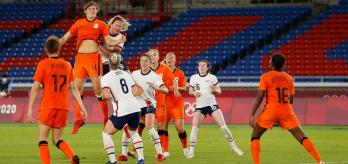The shift from post players to complete zonal marking
The latest edition of the Women’s Olympic Football Tournament marked the end of a gradual tactical evolution relating to how female teams set up to face corner kicks. Sides historically placed players on the goalposts to help the goalkeeper to protect the area around the goalmouth. The tactic of stationing players on the posts was especially important in women’s football because, although the average arm span of a female goalkeeper is smaller than that of their male counterparts, shot-stoppers in the women’s game still have to defend goals of the same dimensions as those used in men’s football.
Now, with corners we are officially in an era where nearly all the teams have said ‘let’s not have defenders marking the posts, let’s get out and mark the space of the players’…we saw this in the Olympics pretty consistently.
For decades, one player would cover the near post, whilst another would be positioned at the far post. However, over time, women’s teams slowly opted to abandon the use of the latter. In recent years, some teams have begun to leave both posts completely unguarded, opting instead to use these players to help mark the space occupied by opposition players attacking the corner. At the Women’s Olympic Football Tournament, this shift from having players standing on both posts to leaving them uncovered seemed to finally be complete, with the majority of teams adopting zonal marking.
Higher backlines
The tournament also witnessed a change in the way in which teams defended free kicks in their defensive third. When defending such set pieces, sides made a conscious tactical decision to push their backline higher up the pitch so as to increase the space between the defence and goalkeeper. This wider space creates a buffer for the custodian. Whereas a keeper would often have previously found herself pushed and impeded by both opponents and team-mates when coming to collect a free kick, the greater space afforded by this new approach means that she now has a clearer path to the ball, which increases the chances of her making a clean catch and turning possession over.









